Virtually Religious:
Technology and Internet Use in American Congregations
by Scott Thumma
March 2011
A report on Internet and technology use by churches and other faith communities based on the Faith Communities Today 2010 survey results.
Visit the Faith Communities Today website
Download a PDF version of this report

Nothing has changed the world in such a short time as the Internet. Public access to the web and email is less than 20 years old while social media like blogs, Twitter and Facebook are still in their infancy, yet well over three-quarters of the adult population makes use of these technologies weekly. No one can agree on how this technology will shape our future but everyone agrees on the fact that we are in the midst of a powerful revolution in communication and personal interaction.
Religious congregations are making dramatic strides in adapting to this reality, though not without unevenness and ineptitude at times. The use of both websites and email by congregations has more than doubled in the past decade. Additionally, technologically-powered projection screens in worship and member databases which organize information are increasingly present in American’s congregations. Newer media forms such as Facebook, blogs, texting and streaming media are still less prevalent but are nevertheless beginning to transform the ways religious groups interact and enhance their sense of community.
The global embrace of Internet technologies has reconfigured the fabric of society for congregations in a contemporary context. Adaptation to these new tools of ministry in the 21st century is no longer the luxury it was in the 1990s. The use of technology is now a congregational necessity that comes with significant ministerial advantages. A congregation that does not strategically employ these technologies is likely to be perceived as out of sync with the contemporary world. More importantly, the intentional use of these technologies has become a valuable tool for congregations to expand their ability to do more with fewer resources.
All faith communities in this day and age should be hybrid congregations, in other words their ministry needs to be part physical and part virtual. Nearly every congregation has members who interact with these technologies in their daily lives. Religious leaders who recognize this and employ these technologies to connect with and minister to their congregational members have a distinct advantage.
This report describes the technological use by religious groups, identifies the factors that either aid or hinder its use, and highlight the positive outcomes for the congregation that embraces the use of technology in all its forms. The report also speculates beyond the Faith Communities Today data to suggest several reasons why all congregations should intentionally develop their technological ministry capabilities, no matter how large or small, technologically adept or unsophisticated.
Overall Patterns of Use
The 2010 Faith Communities Today (FACT2010) national survey of 11,077 congregations found that Internet technologies are being employed by a large majority of congregations. This is a dramatic difference from the roughly one third of congregations that embraced their use a decade ago. Combining the Faith Community Today survey findings with several other national survey results paints a dramatic picture of the rise of Internet technology within congregational life and the impact it is already having.
The use of email by religious groups from 2000 to 2010 more than doubled, rising from 35% to 90% of congregations, as Figure 1 shows.
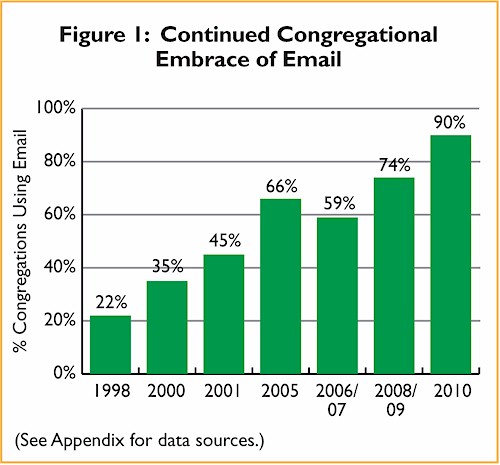
At the same time, congregational use of websites rose from 33 percent to 69 percent between the decennial surveys (Figure 2). The 2010 figure of 69% is a decrease from the 2008 Faith Communities Today survey finding of 74% of congregations with websites. This decline may not indicate a retreat from technology but rather a shift in its use, as discussed below.
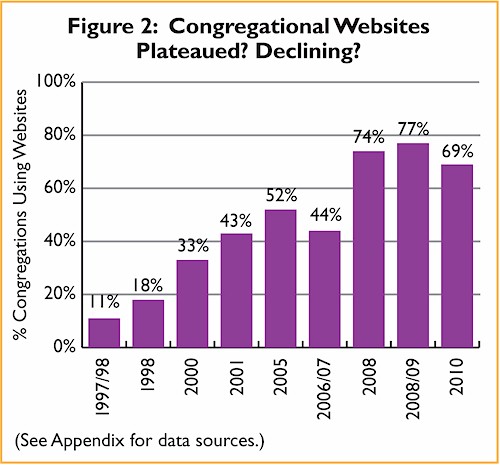
This embrace of technology isn’t quite universal. In FACT 2010, seven percent of congregations had no email or website presence as Figure 3 indicates. Nearly a quarter of congregations only use email without utilizing a congregational website while three percent of congregations had a web presence but no email. Nearly all these low-tech congregations are very small. Yet, two-thirds of the country’s congregations made use of both email and a website. And these technologies are not the only ones that congregational leaders are beginning to employ in their ministry efforts.

The FACT2010 survey explored a variety of other tech features that congregations use on a regular basis. Visual projection and database software tracking of members were by far the most frequently used, having been adopted in some measure by over two-thirds of the nation’s congregations (as can be seen in Figure 5 below).
The Growth of Social Media
With the rapid rise and tremendous success of Facebook, Twitter and other social media applications, congregations are swiftly adopting these tools for their ministry. Over 40% of congregations say they use Facebook, see Figure 5. This is a staggering rate of adoption since the general public use of Facebook was only 4 years old in 2010. In part, the dramatic embrace of Facebook by congregations might provide an explanation for the drop in the percentage of congregational websites the Faith Communities Today found in 2010.
As Figure 4 indicates, seven percent of congregations are on Facebook but do not have a web presence. This may well signal a shift and even a positive trend in the use of technology by religious groups. Currently, few congregational websites are interactive or updated regularly. On the other hand, Facebook pages have a dynamic interactive quality; they are easily updated and offer timely relevant information to a faith community’s “friends.” One distinct drawback of this strategy, however, is that few congregational Facebook pages contain relevant contact information in case outsiders come knocking. Facebook is great for congregational insiders, but may well be less functional as a yellow-pages ad for those shopping for a new faith community home.
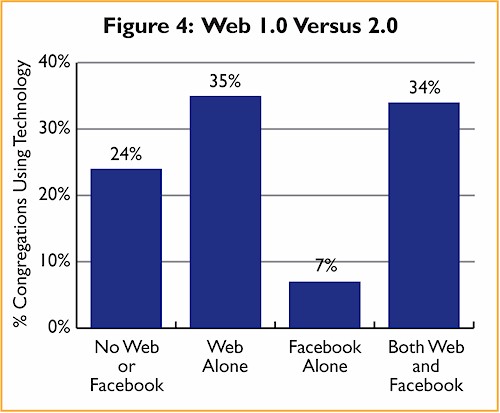
And Facebook is not the only social media being adopted by religious groups. Just over 10% of faith communities report using blogs or podcasts, Figure 5. Additionally, an open-ended “Other” question garnered a long list of various technologies employed by some congregations… everything from phone calling systems and disseminating sermons by CD, DVD or even cassette tape to streaming worship services on the web. Large numbers of congregations employed Goggle calendars, maps and docs, AdWords and Analytics. Some used Flickr, Evites, Youtube, and Texting to enhance their ministry. Many survey respondents reported offering enewsletter versions of their print material. A few congregations even employed online giving, TV and radio broadcasts, twitter feeds, and wireless Internet during the worship service. Two of the 11,000 congregations operated an “Internet campus” of their church, offering virtual worship services with live clergy and a worship team.
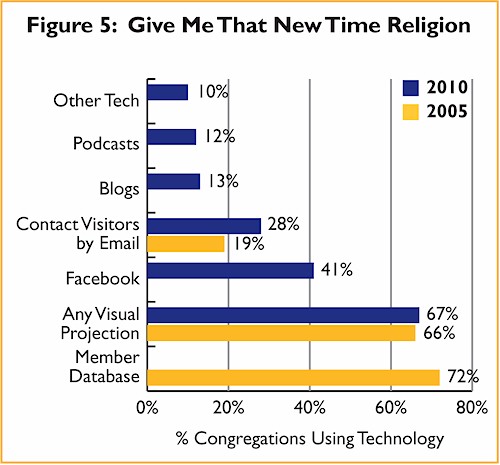
The study didn’t explicitly ask how the congregations used their web sites or email, but based on other recent surveys, such as the US Congregational Life research and Lifeway research much of this use appears to be unidirectional. Overwhelmingly, these technologies are being employed by congregations to communicate to the membership rather than taking full advantage of the media’s interactivity.
However, looking closely at how clergy and laity say they use email suggests it is a more dynamic communication channel. Additionally, almost a third of congregations indicate they connect with first-time visitors by email. This technological interactivity is further enhanced through the increasing use of Facebook. As such some congregational leaders are beginning to realize the media’s potential, but this embrace is still quite uneven, some do it much better than others.
The Gaps in Religious Technology
Previous research on Internet technologies have shown generational, gender, income, and educational gaps exist between individuals that embrace or shun tech use. Based on the FACT2010 survey, the same is true for congregations. The size of a congregation is the primary factor in its level of tech use. Likewise, the wealthier the congregation, at any size, the more likely it is to be employing technology. Membership dynamics also play a role in widening this gap. After controlling for the strong influence of size, the age, gender, education and racial makeup of the membership and senior leadership affect a congregation’s embrace of technology. Additionally, among Protestant Christian groups, theological differences also play a role in distinguishing between more and less tech-adept faith communities. These variables that enhance or hinder robust tech use in congregations become even more apparent when all the technological measures in the survey are clustered together in a three-point scale of no or marginal tech use, modest use and major use of the Internet and computer-aided technologies.
Size
Even given the near universal nature of email and websites among faith communities, the 2010 study found that a significant gap exists between the smallest congregations and other sized religious groups in terms of technology use. Website and Facebook use is far less prevalent in congregations with 50 or less attenders than it is in those over 250, as evidenced in Figure 6.

Figure 7 shows that the three-point technology scale demonstrates even more dramatically the impact of size on technology use. Over half of the small congregations are technological luddites while almost half those over 250 attenders are major tech users.

Do larger congregations use technology because they are big or did the get larger due to their tech use? Kirk Hadaway noted in an earlier church growth report, Facts on Growth, based on this survey that the use of multiple technologies does have a positive effect on growth when controlling for initial size in 2005. Therefore, both are true; tech is increasingly necessary as a congregation grows larger as well as the more tech it uses, the more likely it is to grow. This relationship will be explored further below.
Age
Not surprisingly, age has a profound influence on the use of technology. Interestingly, the age structure of the congregation affected the tech issue in three different ways as Table 1 indicates. Robust technology use was diminished if 1) the membership was older, 2) the pastor or primary clergyperson was older, 3) and even if the congregation itself was older, i.e. the longer ago it was founded the less likely it was to embrace technology.

These patterns remained significant whether looking at just email and website use or the full scale of tech items, even after controlling for the size of congregations.
Gender
Previous research on Internet usage has also shown a considerable gender gap. Given that the average congregation is over 60 percent female, one might not expect the gender gap to be evident in congregations, but it exists here as well. The larger the percentage of female members, the less likely the congregation is to employ a wide array of technology. This gender distinction is even more striking when examining the gender of the religious leader as Figure 8 indicates. If a congregation has female clergy, even controlling for size, it is much less likely to have robust technological use.
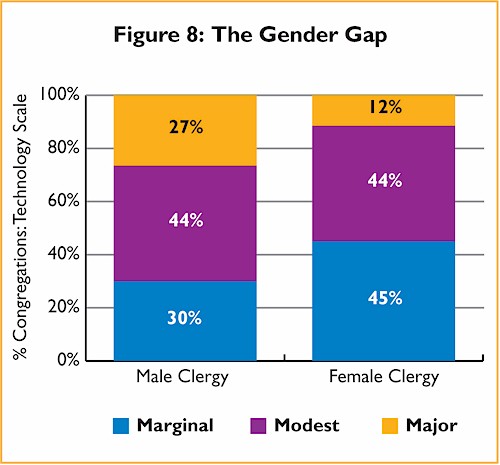
Race
A gap between those congregations with and without technology can also be seen across racial groups. The study had too few cases in several racial groups for adequate comparison; nevertheless, the comparisons in Table 2 are instructive. Interestingly, the dynamics of multiracial congregations appear to be distinctively different when it comes to their embrace of technology. A full 84% of these congregations with no majority racial group had modest to major tech use. However, these congregations are also on average more likely to be larger, have younger members and be more recently established and thus be predisposed toward technology.

A comparison of the two largest racial groupings, predominantly African American and Caucasian congregations, shows a distinctive difference in their use of technology. Comparing these racial distinctions across attendance size groupings in Figure 9 reveals that white congregations utilize even the most basic email and website technologies at a greater rate than do black congregations for almost every size category. The same pattern holds true for the combined technology scale as well.
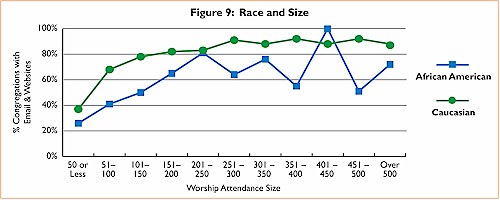
Theology and other differences
Interestingly a theological gap could be seen in the technological usage between the mainline (or oldline as David Roozen suggests in A Decade of Change) and more evangelical Protestant churches (Figure 10). Controlling for size, this distinction remained; however, controlling for age of the congregational members diminished this difference a bit but not entirely. Given the considerably older membership profile of the mainline that Roozen found in an earlier report on this research and the suppressing effect of age on tech use, it seems unlikely that many of these Mainline congregations will adopt these technologies with great enough frequency to attract younger generations.
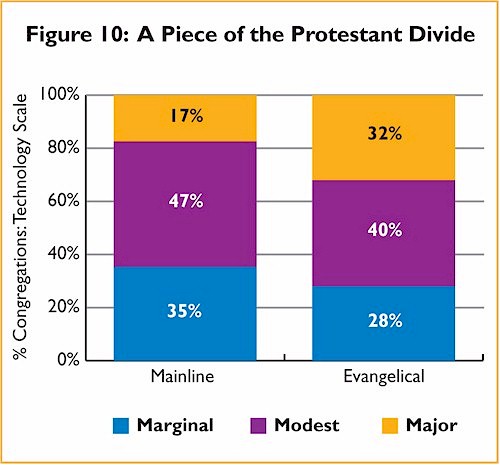
Not too surprising, the greater income a congregation had, within any size grouping, the more likely it was to employ technology. Somewhat unexpectedly, however, neither the education level of the clergy or members nor the region of the country had a significant effect on the technological use of a congregation.
The recognition that technological gaps exist is necessary but it is even more important that this knowledge fuel greater efforts to overcome the lag in some faith communities. The embrace of technology is crucial in the contemporary context not only to connect with current members but also to attract new generations of participants for whom technology is like the air they breathe.
Multiple Benefits of Using Technology
The FACT2010 survey uncovered a number of reasons for the relationship between vital, growing faith communities and their adoption of technology.
Innovativeness
The most critical reason for awakening to the necessity of technology in congregational life is the realization that the social context has changed. Congregations must change with this social shift in order to keep their presentation of faith relevant. Increased use of tech is strongly related to the congregation being characterized by willingness to change to meet new challenges (Figure 11).
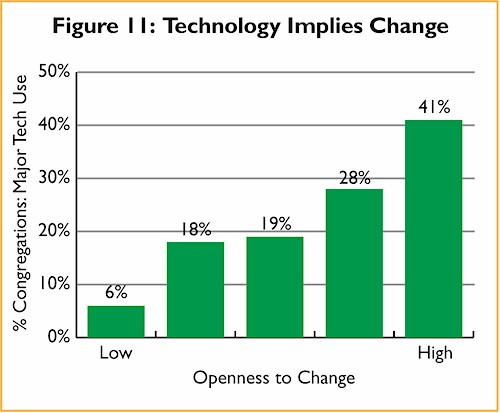
Not surprisingly, this also correlates to the likelihood that the congregation altered its worship style in the past 5 years as well as this worship being described as innovation. Figure 12 shows that as the use of technology in a congregation increases so too does the likelihood that it will use drums and electric guitars, hence have contemporary worship.

Distinctiveness
In this day and age, all congregations compete for members. No congregation has a guaranteed constituency or a religious monopoly. Congregations that have a distinctive vision, a clear sense of mission and purpose and those who are distinctive in the “religious marketplace” have a natural advantage. Increased technological use enhances that distinctiveness and increases their competitive edge.

As Figures 13 & 14 show, increased use of technology correlates with a clear vision and with being distinctive from other congregations in its neighborhood. Not only do those congregations with major tech use stand out but they have the technological means to promote and disseminate their distinctively more effectively both to their own members and those in the surrounding community.
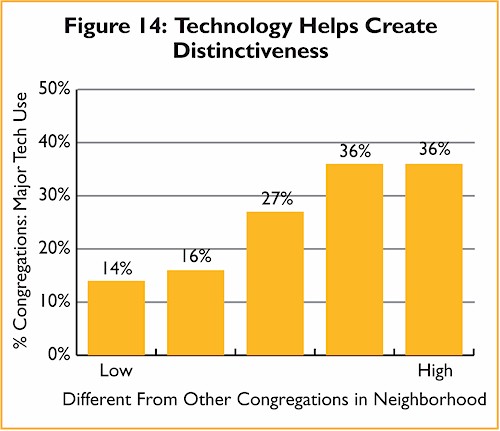
Vitality
Additionally, congregations with a greater use of technology (especially when combined with electronic instruments and projection screens) are more likely to describe their worship as innovative, joyful, thought-provoking, and inspirational. Faith communities that embrace greater use of technology are also perceived as being more spiritually vital. Perhaps even more importantly, these perceptions also have an effect on member participation and involvement.
The positive impact of tech on participation is most clearly seen in the Faith Communities Today study related to the percentage of members who were engaged in recruiting others to attend. Roughly 50 percent of faith communities with major tech use said a lot of their members are involved in bringing others into the congregation (Figure 15).
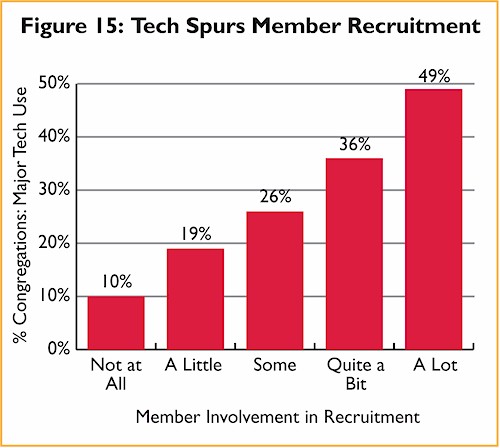
Interestingly, even per capita giving increases as the use of technology rises, as Figure 16 shows. Many factors affect giving, especially the size of a congregation as can be seen in the figure. It is instructive however, that increased tech use by the smallest and largest sized faith communities significantly generates greater per capita giving. Of course, it is also true that greater resources make it more likely a congregation can afford more technology.
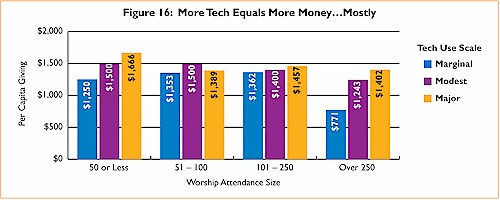
Congregational Growth
Increased tech use is no guarantor of growth. More specifically, it is not a sure-fire panacea for struggling congregations. As David Roozen indicated in A Decade of Change, there is an odd high level of tech use in congregations in rapid decline as well as those rapidly growing, see Figure 17. Further analysis suggests this counter-intuitive finding is less a matter of religious leaders in declining congregations trying anything to survive, and more a factor of other circumstances at work, specifically conflict, that counteract the positive technological effect.
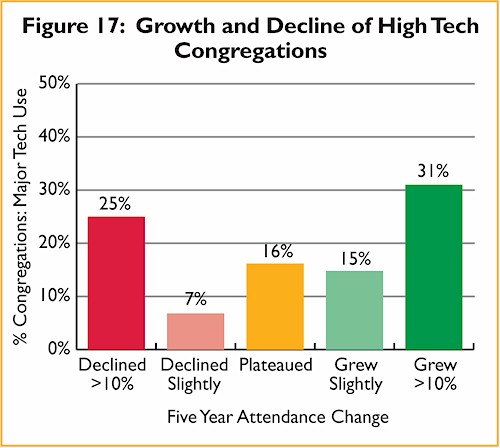
An analysis of just those high tech congregations in serious decline indicated that over half experienced higher levels of conflict around member behavior, clergy leadership style, program priorities than those with less technology. Even more significant in understanding this tech-decline connection, two-thirds of this group had conflict around how worship was conducted in the past 5 years. In a third of the congregations, the situation resulted in people leaving. The embrace of technology, especially projection screens in worship, may factor into this conflict but it also may just be a marker for a larger effort to change the congregational culture. Tech use implies change. Conflict is frequently a consequence of change. The ability to constructively manage or channel conflict is frequently a key to the successful incorporation of technology into congregational life.
More important than any direct correlation with congregational growth or decline, greater tech use is clearly one of several factors that nurture growth. When technology is combined with willingness to change, contemporary worship, a clear vision and sense of purpose, and younger members and families the growth potential of a faith community increases dramatically. All these variables correlate strongly with the most robust use of technology, and also result in a greater likelihood of growth. As Hadaway suggested in an earlier report on growing congregations entitled Facts on Growth, the embrace of technology “is part of a constellation of activities that congregations use to enhance their growth possibilities.” At the same time, without the intentional focus of using this technology in a ministerial strategy, the potential gain is wasted. The latent potential for enhancing ministry through technological means is significant.
An Expanded and Enhanced Ministry –
moving beyond the data
The space in which religious life happens can be expanded technologically. The use of Internet technologies takes “congregational life” beyond the physical limits of the weekend assembly. In other words, technology at its best can create virtual times and ways for “2 or more to be gathered together.” The strategic use of technology by congregations need not be complex or difficult. The technological benefit of expanding the space for religious community can perform a number of critical functions to enhance any congregation’s ministry.
Judicious use of tech and social media can make congregational activities more congruent with the everyday lives of members. Ordinary members’ lives are enmeshed in technology. If their faith isn’t also, then it is less relevant in modern American society. Technology can bring a media-rich everyday world into the worship service, whether it is simply using tech examples in sermons or more robustly, watching clips of the latest movies to illustrate a verbal point, receiving feedback and questions to the sermon through text messages, watching videos of recent ministry activities or even skyping with youth during their mission trip.
Properly employed, technology can make members’ daily lives outside of the worship service richer with religious meaning. Tech blurs what, when and where faith and religious community connections happen. It can function as a medium to carry one’s faithful living into everyday life – whether sharing prayer requests on Facebook, tweeting about a recent sermon, surfing to religious websites, or actually participating in online worship services.
Strategic use of technology can further enhance the number and depth of ties between members thus solidifying the connections between members and leaders. This may well create a stronger and more intimate congregation. Technology can enrich the community and fellowship opportunities available to interact with others in the congregation. Facebook offers a particularly good example of this. While most members do not specifically log onto Facebook for faith, they are there with their friends in an online community. These “friends” nearly always include people from their faith communities and friends of friends who are religiously oriented. For these faithful persons, Facebook inevitably ends up at times being a prayer and support group, a virtual fellowship hall, and a “between Sundays” gathering place.
And above all, the intentional and strategic use of technology by congregations demonstrates that faith and ministry are relevant and congruent to the contemporary context especially for younger generations. As noted previously, this may not happen without pain and conflict, but any growth and change can cause discomfort. However, avoiding this possible painful effort may well mean closing a congregation’s virtual doors to a new high-tech generation.
Ministry should be, even must be, a technological hybrid venture in this day and age. But technology is not an end in itself. It has to be employed strategically and intentionally as a component of the overall ministry effort of the congregation. It is not a matter of having a webpage, a Facebook account or projection screens, but of using these to enhance and expand the activities and communal life of the congregation.

Appendix
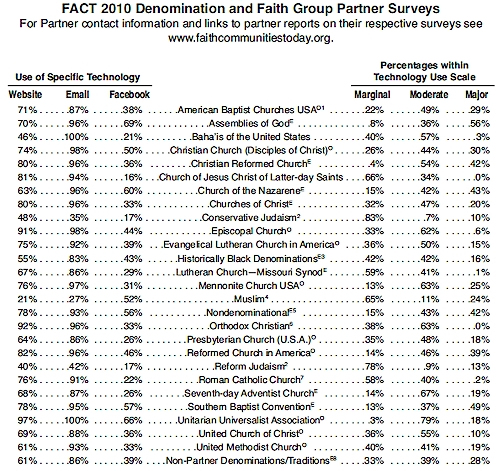
Protestant Families: E - Evangelical; O – Oldline/Mainline
1 Low response rate warrants caution.
2 Conducted by Synagogue 3000. Includes the Conservative and Reformed Traditions.
3 Conducted by the Interdenominational Theological Center. Low response rate warrants caution.
4 Conducted by the Islamic Society of America. Low response rate warrants caution.
5 Conducted by the Hartford Institute for Religion Research. Low response rate warrants caution.
6 Conducted by the Standing Conference of Canonical Orthodox Bishops in America.
7 Conducted by the Center for Applied Research in the Apostolate (CARA).
8 Conducted by a subcontractor of the Cooperative Congregational partnership. Low response rate warrants caution.
The Faith Communities Today Surveys
The FACT2010 national data set brings together the 26 individual surveys of congregations listed on the previous page. Twenty-four were conducted by or for partner denominations and faith groups, representing 32 of the country’s largest denominations and traditions. The Cooperative Congregational Studies Partnership (CCSP) developed a common core questionnaire of just over 150 questions consisting of items from the FACT2000 (14,301 congregations), FACT2005 (884 congregations) and FACT2008 (2,527 congregations) surveys. Copies of all questionnaires are available at www.faithcommunitiestoday.org Consult the questionnaires for the exact wording of items used in this report.
Using the common questionnaire, CCSP partners conducted their own, typically by mail or online, surveys of a representative, random national sample of their own congregations. Usually a congregation’s leader completed the questionnaire. CCSP also conducted a national survey of nondenominational congregations based on a complied database of independent and nondenominational churches in the US. Finally, CCSP contracted with a denominational agency to survey a sample of nonpartner denomination congregations, also based on a random sample drawn from several mailing and marketing lists.
For purposes of the overall national analysis, the 26 subsurveys were combined in such a way that, through the use of statistical weights, each partner denomination and faith group and each non-partner cluster of congregations is represented in the national. FACT2010 data proportionate to its representation in the total population of congregations in the United States. This aggregated data set includes responses from 11,077 congregations, and over 120 denominations. Return rates were good for surveys of this type – in the 40% range. Subsurveys with lower return rates are noted in the appendix. Sampling error for a survey such as FACT2010 can only be roughly estimated. We believe a conservative estimate is +/- 4% at the 95% confidence level.
The Faith Communities Today Project
The FACT series of national surveys of American Congregations is a project of the Cooperative Congregational Studies Partnership (CCSP). CCSP is a multifaith coalition of denominations and religious groups hosted by Hartford Seminary’s Hartford Institute for Religion Research. CCSP denominations and religious groups participating in FACT2010 are listed on the previous page. More information about CCSP, its partners, its publications, the FACT surveys and how to subscribe to its monthly newsletter is available at www.faithcommunitiestoday.org.
Virtually Religious: Technology and Internet Use in American Congregations was written by Scott Thumma, Hartford Institute for Religion Research, Professor of Sociology of Religion, Hartford Seminary.
For contact information visit www.hartfordinstitute.org/about/thumma.htm
References for Figure 1 & 2:
1997/98 – Organizing Religious Work Hartford Institute
1998 – National Congregations Study wave 1 Mark Chaves
2000 – Barna Research
2001 – US Congregational Life Survey wave 1 & 2 Cynthia Woolever & Deborah Bruce (written by Ida Smith-Williams)
2005 – Faith Communities Today
2006/07 – National Congregations Study wave 2 Mark Chaves
2008 – Faith Communities Today
2008/09 – US Congregational Life Survey wave 1 & 2 Cynthia Woolever & Deborah Bruce (written by Ida Smith-Williams)
2010 – Faith Communities Today
Copyright © 2012 Graphic Design by Richard Houseal
Hartford Institute for Religion Research
Hartford Seminary 77 Sherman Street Hartford, CT 06105
Download a PDF of this report
|
